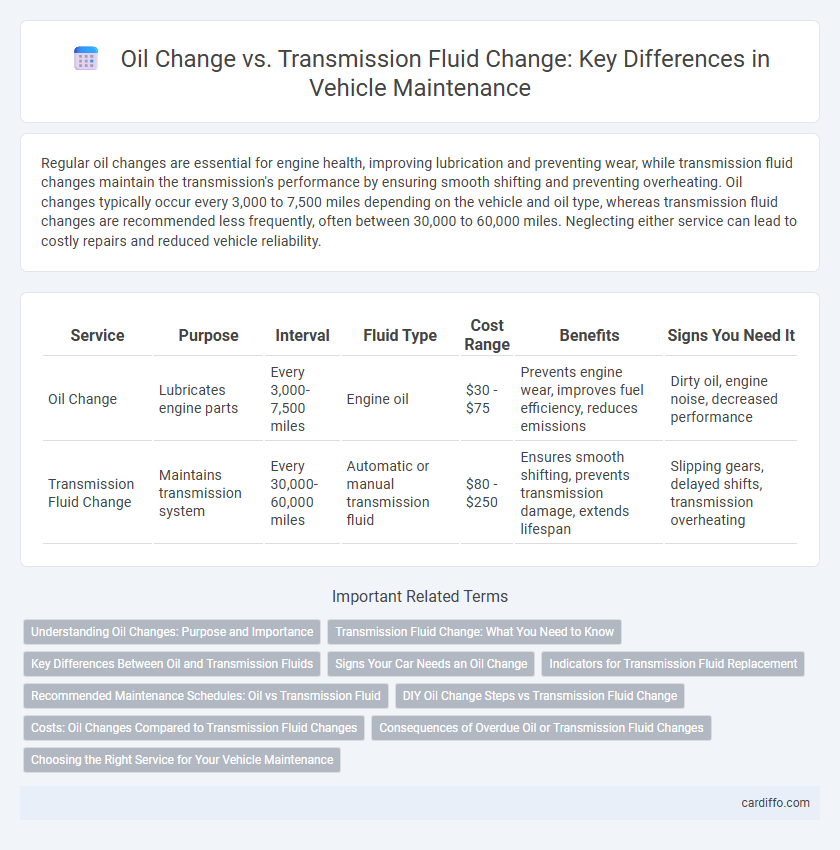Regular oil changes are essential for engine health, improving lubrication and preventing wear, while transmission fluid changes maintain the transmission's performance by ensuring smooth shifting and preventing overheating. Oil changes typically occur every 3,000 to 7,500 miles depending on the vehicle and oil type, whereas transmission fluid changes are recommended less frequently, often between 30,000 to 60,000 miles. Neglecting either service can lead to costly repairs and reduced vehicle reliability.
Table of Comparison
| Service | Purpose | Interval | Fluid Type | Cost Range | Benefits | Signs You Need It |
|---|---|---|---|---|---|---|
| Oil Change | Lubricates engine parts | Every 3,000-7,500 miles | Engine oil | $30 - $75 | Prevents engine wear, improves fuel efficiency, reduces emissions | Dirty oil, engine noise, decreased performance |
| Transmission Fluid Change | Maintains transmission system | Every 30,000-60,000 miles | Automatic or manual transmission fluid | $80 - $250 | Ensures smooth shifting, prevents transmission damage, extends lifespan | Slipping gears, delayed shifts, transmission overheating |
Understanding Oil Changes: Purpose and Importance
Oil changes are essential for maintaining engine performance by lubricating moving parts, reducing friction, and preventing overheating. Regular oil replacement helps remove contaminants and sludge that can cause engine wear and reduce fuel efficiency. Understanding the purpose of oil changes ensures timely maintenance, extending the engine's lifespan and improving overall vehicle reliability.
Transmission Fluid Change: What You Need to Know
Transmission fluid change is essential for preserving the efficiency and longevity of your vehicle's transmission system by preventing overheating and ensuring smooth gear shifts. Unlike engine oil, transmission fluid lubricates, cools, and cleans internal transmission components while providing hydraulic pressure for gear engagement. Regular transmission fluid service intervals, typically every 30,000 to 60,000 miles, vary by manufacturer and driving conditions, so consulting your vehicle's maintenance schedule is crucial.
Key Differences Between Oil and Transmission Fluids
Engine oil primarily lubricates, cools, and cleans engine components, while transmission fluid lubricates and cools the transmission system's moving parts. Oil changes typically occur every 3,000 to 7,500 miles depending on vehicle and oil type, whereas transmission fluid change intervals are longer, often between 30,000 to 60,000 miles. Transmission fluid also acts as a hydraulic fluid to enable gear shifts, making its composition and function distinctly different from engine oil.
Signs Your Car Needs an Oil Change
Visible signs your car needs an oil change include dark, dirty oil on the dipstick and a strong burning smell inside the vehicle. Engine performance issues such as sluggish acceleration, knocking noises, or the check engine light illuminating also indicate deteriorated oil quality. Regularly monitoring oil level and consistency prevents damage and maintains optimal engine function.
Indicators for Transmission Fluid Replacement
Transmission fluid replacement is crucial when indicators such as a burnt odor, dark or murky fluid color, or delayed gear shifting become apparent. Regularly checking transmission fluid levels and condition helps prevent costly repairs and ensures smooth operation of the vehicle's gearbox. Manufacturers typically recommend transmission fluid changes every 30,000 to 60,000 miles, but this interval can vary based on driving habits and vehicle model.
Recommended Maintenance Schedules: Oil vs Transmission Fluid
Recommended oil change intervals typically range from 3,000 to 7,500 miles depending on vehicle type and oil quality, ensuring engine lubrication and performance. Transmission fluid change schedules vary widely, often suggested between 30,000 and 60,000 miles to maintain optimal transmission operation and prevent costly repairs. Following manufacturer guidelines for both oil and transmission fluid changes is critical for prolonging vehicle lifespan and enhancing overall reliability.
DIY Oil Change Steps vs Transmission Fluid Change
Performing a DIY oil change involves draining the old engine oil, replacing the oil filter, and refilling with the manufacturer's recommended oil type and quantity, typically every 3,000 to 7,500 miles. In contrast, a transmission fluid change requires locating the transmission drain plug or pan, draining the old fluid, cleaning or replacing the transmission filter, and refilling with the appropriate transmission fluid, often demanding more tools and technical knowledge due to the complexity of the transmission system. Regular maintenance of both fluids ensures optimal vehicle performance and longevity, with oil changes generally being more accessible for DIY enthusiasts compared to the specialized procedure of transmission fluid replacement.
Costs: Oil Changes Compared to Transmission Fluid Changes
Oil changes typically cost between $30 and $70, depending on the vehicle and oil type, while transmission fluid changes range from $120 to $250 due to the more complex process and fluid requirements. Oil changes require less time and fewer materials, making them a more affordable routine maintenance task. Transmission fluid changes often involve draining, flushing, and refilling, contributing to higher labor and service costs.
Consequences of Overdue Oil or Transmission Fluid Changes
Overdue oil changes can lead to engine sludge buildup, reduced lubrication, and increased wear, resulting in decreased engine performance and costly repairs. Neglecting transmission fluid changes causes poor shifting, overheating, and transmission failure due to contaminated fluid losing its lubricating and cooling properties. Regular maintenance intervals for both oil and transmission fluid are critical to prevent mechanical breakdowns and extend vehicle longevity.
Choosing the Right Service for Your Vehicle Maintenance
Selecting the appropriate service between oil change and transmission fluid change depends on your vehicle's specific maintenance schedule and driving conditions. Oil changes ensure engine lubrication and prevent wear, while transmission fluid changes maintain smooth gear shifts and prevent transmission overheating. Consulting your vehicle's manual and monitoring fluid quality are essential to optimize performance and extend engine and transmission lifespan.
Oil Change vs Transmission Fluid Change Infographic

 cardiffo.com
cardiffo.com